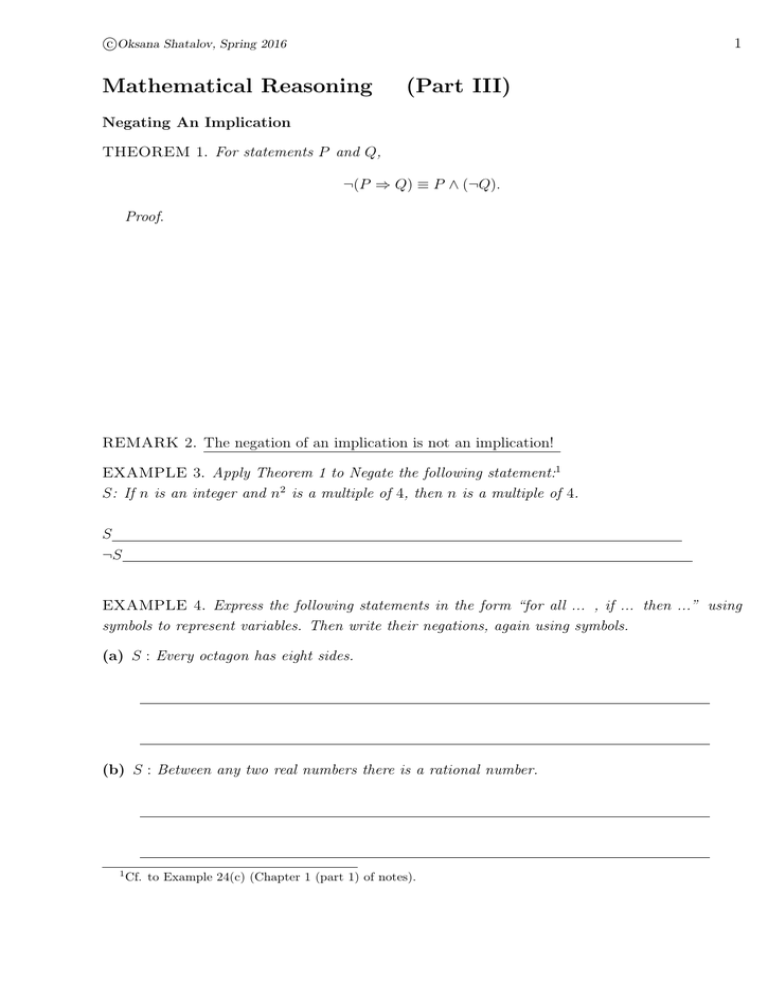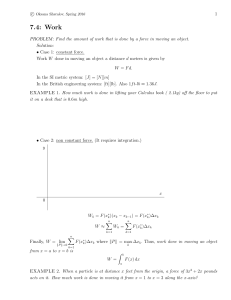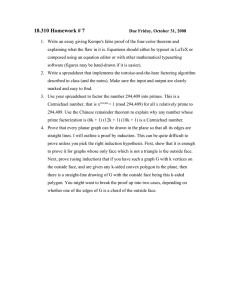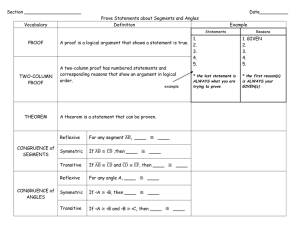Document 10581226
advertisement

c Oksana Shatalov, Spring 2016 1 Mathematical Reasoning (Part III) Negating An Implication THEOREM 1. For statements P and Q, ¬(P ⇒ Q) ≡ P ∧ (¬Q). Proof. REMARK 2. The negation of an implication is not an implication! EXAMPLE 3. Apply Theorem 1 to Negate the following statement:1 S: If n is an integer and n2 is a multiple of 4, then n is a multiple of 4. S ¬S EXAMPLE 4. Express the following statements in the form “for all ... , if ... then ...” using symbols to represent variables. Then write their negations, again using symbols. (a) S : Every octagon has eight sides. (b) S : Between any two real numbers there is a rational number. 1 Cf. to Example 24(c) (Chapter 1 (part 1) of notes). c Oksana Shatalov, Spring 2016 2 Disproving Statements Case 1. Counterexamples Let S(x) be an open sentence over a domain D. If the quantified statement ∀x ∈ D, S(x) is false, then its negation is true, i.e. Such an element x is called a counterexample of the false statement ∀x ∈ D, S(x). EXAMPLE 5. Disprove the statement: “If n ∈ O, then 3|n2 + 2.” Solution. EXAMPLE 6. Negate the statement: “For all x ∈ D, P (x) ⇒ Q(x).” The value assigned to the variable x that makes P (x) true and Q(x) false is a counterexample of the statement “For all x ∈ D, P (x) ⇒ Q(x).” EXAMPLE 7. S: If n is an integer and n2 is a multiple of 4 then n is a multiple of 4. Question: Is the following “proof ” valid? Let n = 6. Then n2 = 62 = 36 and 36 is a multiple of 4, but 6 is not a multiple of 4. Therefore, the statement S is FALSE. EXAMPLE 8. Disprove the following statement: If a real-valued function is continuous at some point, then this function is differentiable there. Case 2: Existence Statements Consider the quantified statement ∃x ∈ D 3 S(x). If this statement is false, then its negation is true, i.e. c Oksana Shatalov, Spring 2016 3 EXAMPLE 9. Disprove the statement: “There exists an even integer n such that 3n + 5 is even.” Methods to prove an implication P ⇒ Q (continued) THEOREM 10. Let S and C be statement forms. Then ¬S ⇒ (C ∧ ¬C) is logically equivalent to S. Proof. COROLLARY 11. Let P , Q and C be statement forms. Then (P ⇒ Q) ≡ ((P ∧ ¬Q) ⇒ (C ∧ ¬C)) Proof. • PROOF BY CONTRADICTION – Assume that P is true. – To derive a contradiction, assume that ¬Q is true. – Prove a false statement C, using negation ¬(P ⇒ Q) ≡ (P ∧ ¬Q). – Prove ¬C. It follows that Q is true. (The statement C ∧ ¬C must be false, i.e. a contradiction.) REMARK 12. If you use a proof by contradiction to prove that S, you should alert the reader about that by saying (or writing) one of the following – Suppose that the statement S is false. – Assume, to the contrary, that the statement S is false. – By contradiction, assume, that the statement S is false. c Oksana Shatalov, Spring 2016 4 REMARK 13. If you use a proof by contradiction to prove that P ⇒ Q, your proof might begin with – Assume, to the contrary, that the statement P is true and the statement Q is false. or – By contradiction, assume, that the statement P is true, but ¬Q is false. REMARK 14. If you use a proof by contradiction to prove the quantified statement ∀x ∈ D, P (x) ⇒ Q(x), then the proof begins by assuming the existence of a counterexample of this statement. Therefore, the proof might begin with: – Assume, to the contrary, that there exists some element x ∈ D for which P (x) is true and Q(x) is false. or – By contradiction, assume, that there exists an element x ∈ D such that P (x) is true, but ¬Q(x) is false. EXAMPLE 15. Prove that there is no smallest positive real number. PROPOSITION 16. If m and n are integers, then m2 6= 4n + 2. Proof. c Oksana Shatalov, Spring 2016 5 COROLLARY 17. The equation m2 − 4n = 2 has no integer solutions. COROLLARY 18. If the square of an integer is divided by 4, the remainder cannot be equal 2. COROLLARY 19. The square of an integer cannot be of the form 4n + 2, n ∈ Z. PROPOSITION 20. Let a, b, and c be integers. If a2 + b2 = c2 then a or b is an even integer. Proof. DEFINITION 21. A real number x is rational if x = Also, x is irrational if it is not rational, that is m n for some integer numbers m and n. m The fraction is reduced to lowest terms, if the integers m and n have no common factors n except ±1. c Oksana Shatalov, Spring 2016 PROPOSITION 22. The number 6 √ 2 is irrational. A Review of Three Proof Techniques EXAMPLE 23. Prove the following statement by a direct proof, by a proof by contrapositive and by a proof by contradiction: “If n is an even integer, then 5n + 9 is odd.” c Oksana Shatalov, Spring 2016 7 How to prove (and not to prove) that ∀x ∈ D, P (x) ⇒ Q(x). 1 2 3 4 5 6 7 8 9 10 First step of “Proof ” Assume that there exists x ∈ P (x) is true. Assume that there exists x ∈ P (x) is false. Assume that there exists x ∈ Q(x) is true. Assume that there exists x ∈ Q(x) is false. Assume that there exists x ∈ P (x) and Q(x) are true. Assume that there exists x ∈ P (x) is true and Q(x) is false. Assume that there exists x ∈ P (x) is false and Q(x) is true. Assume that there exists x ∈ P (x) and Q(x) are false. Assume that there exists x ∈ P (x) ⇒ Q(x) is true. Assume that there exists x ∈ P (x) ⇒ Q(x) is false. Technique Goal D such that D such that D such that D such that D such that D such that D such that D such that D such that D such that Existence Proofs An existence theorem can be expressed as a quantified statement ∃x ∈ D 3 S(x) : There exists x ∈ D such that S(x) is true. A proof of an existence theorem is called an existence proof. √ EXAMPLE 24. There exists real numbers a and b such that a2 + b2 = a + b. Proof. THEOREM 25. (Intermediate Value Theorem of Calculus) If f is a function that is continuous on the closed interval [a, b] and m is a number between f (a) and f (b), then there exists a number c ∈ (a, b) such that f (c) = m. c Oksana Shatalov, Spring 2016 8 EXAMPLE 26. Prove that following equation has a real number solution (a root) between x = 2/3 and x = 1: x3 + x2 − 1 = 0. Uniqueness Proof An element belonging to some prescribed set D and possessing a certain property P is unique if it is the only element of D having property P . Typical ways to prove uniqueness: 1. By a direct proof: Assume that x and y are elements of D possessing property P and show that x = y. 2. By a proof by contradiction: Assume that x and y are distinct elements of D and show that x = y. EXAMPLE 27. Prove that following equation has a unique real number solution (a root) between x = 2/3 and x = 1: x3 + x2 − 1 = 0. c Oksana Shatalov, Spring 2016 9 Induction2 ”Domino Effect” Step 1. The first domino falls. Step 2. When any domino falls, the next domino falls. Conclusion. All dominos will fall! THEOREM 28. 3 (First Principle of Mathematical Induction) Let P (n) be a statement about the positive integer n. Suppose that P (1) is true. Whenever k is a positive integer for which P (k) is true, then P (k + 1) is true. Then P (n) is true for every positive integer n. Strategy The proof by induction consists of the following steps: Basic Step: Verify that P (1) is true. Induction hypothesis: Assume that k is a positive interger for which P (k) is true . Inductive Step: With the assumption made, prove that P (k + 1) is true. Conclusion: P (n) is true for every positive integer n. EXAMPLE 29. Prove by induction the formula for the sum of the first n positive integers 1 + 2 + 3 + ... + n = 2 3 This topic is covered in Section 5.2 in the textbook. We will prove this theorem later. n(n + 1) . 2 (1) c Oksana Shatalov, Spring 2016 10 EXAMPLE 30. Find the sum of all odd numbers from 1 to 2n + 1 (n ∈ Z+ ). EXAMPLE 31. Prove by induction the following formula 12 + 22 + 32 + . . . + n2 = n(n + 1)(2n + 1) 6







